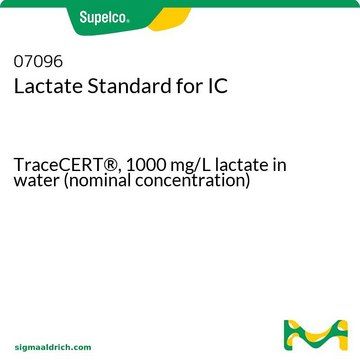PHR1215
Lactic acid
Pharmaceutical Secondary Standard; Certified Reference Material
Synonyme(s) :
DL-Lactic acid, 2-Hydroxypropionic acid
About This Item
Produits recommandés
Qualité
certified reference material
pharmaceutical secondary standard
Niveau de qualité
Agence
traceable to USP 1356734
Famille d'API
lactic acid
Forme
liquid
CofA (certificat d'analyse)
current certificate can be downloaded
Technique(s)
HPLC: suitable
gas chromatography (GC): suitable
Indice de réfraction
n20/D 1.425 (lit.)
pb
122 °C/15 mmHg (lit.)
Densité
1.209 g/mL at 25 °C (lit.)
Application(s)
cleaning products
cosmetics
food and beverages
personal care
pharmaceutical (small molecule)
Température de stockage
2-8°C
Chaîne SMILES
CC(O)C(O)=O
InChI
1S/C3H6O3/c1-2(4)3(5)6/h2,4H,1H3,(H,5,6)
Clé InChI
JVTAAEKCZFNVCJ-UHFFFAOYSA-N
Vous recherchez des produits similaires ? Visite Guide de comparaison des produits
Description générale
Pharmaceutical secondary standards for application in quality control, provide pharma laboratories and manufacturers with a convenient and cost-effective alternative to the preparation of in-house working standards.
Application
- Quantitative analysis of four short-chain fatty acids and lactic acids by high-performance liquid chromatography (HPLC) combined with a UV detector from the supernatant of bacterial cultures
- Spectrophotometric determination of lactic acid at 390 nm in biological cultural and dairy products
Remarque sur l'analyse
Note de bas de page
Produits recommandés
Application
Produit(s) apparenté(s)
Mention d'avertissement
Danger
Mentions de danger
Classification des risques
Eye Dam. 1 - Skin Corr. 1C
Risques supp
Code de la classe de stockage
8A - Combustible corrosive hazardous materials
Classe de danger pour l'eau (WGK)
WGK 1
Point d'éclair (°F)
235.4 °F - closed cup
Point d'éclair (°C)
113 °C - closed cup
Faites votre choix parmi les versions les plus récentes :
Certificats d'analyse (COA)
Désolés, nous n'avons pas de COA pour ce produit disponible en ligne pour le moment.
Si vous avez besoin d'assistance, veuillez contacter Service Clients
Déjà en possession de ce produit ?
Retrouvez la documentation relative aux produits que vous avez récemment achetés dans la Bibliothèque de documents.
Les clients ont également consulté
Protocoles
Separation of DL-Lactic acid, ~90% (T)
Separation of Pyruvic acid, United States Pharmacopeia (USP) Reference Standard; Tartaric acid, United States Pharmacopeia (USP) Reference Standard; Citric acid, United States Pharmacopeia (USP) Reference Standard; Malic acid, United States Pharmacopeia (USP) Reference Standard; L-Pyroglutamic acid, ≥99.0% (T); Lactic acid, United States Pharmacopeia (USP) Reference Standard; Acetic acid, ≥99.99% trace metals basis; Succinic acid, United States Pharmacopeia (USP) Reference Standard
Chromatograms
application for HPLCapplication for HPLCNotre équipe de scientifiques dispose d'une expérience dans tous les secteurs de la recherche, notamment en sciences de la vie, science des matériaux, synthèse chimique, chromatographie, analyse et dans de nombreux autres domaines..
Contacter notre Service technique






